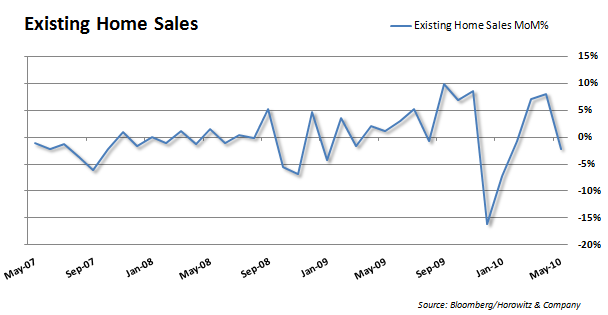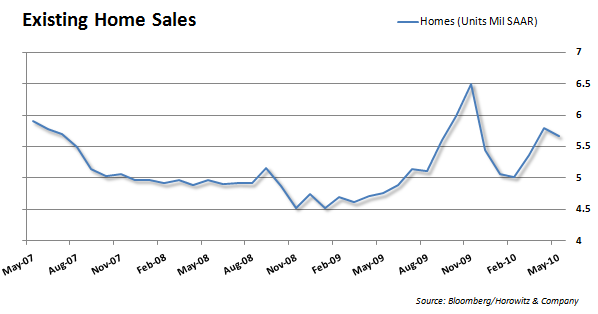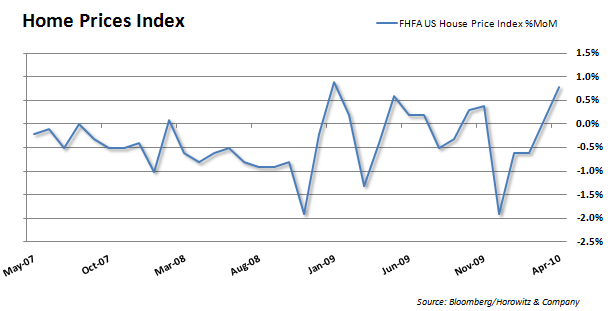There is no way around it, existing home sales came in below expectations. This is not surprising to some who saw that mortgage rates close to historic lows could not stir up an conviction from buyers. 
Of course we can also point the the fact that unemployment remains stubbornly high and that even with consumer confidence on the rise, there is hesitancy to commit. But, the inventory on the market needs to be sopped up in order to bring up housing prices.
Even so, there also was a very nice move higher in the home price index, up 0.8% versus expectations for 0.3%./ That is good news for sellers, showing that buyers are stepping up their offers.
With this report showing weakness and other data on housing not very encouraging, it is hard to excited about tomorrow’s housing starts new home sales number.
But, in the end, does our economy still revolve around real estate?
Existing home sales fell 2.25% to 5.66 million in May from a revised April figure of 5.79 million. Since March, sales had been growing strongly with the home buyer tax credit, growing 7% in March and 8% in April. Although the home buyer tax credit’s deadline to sign a contract was April 30, the deadline for completing a home purchase associated with the tax credit is not until June 30. Existing home sales, which are measured at contract closing, could have continued to grow into May aided by the tax credit. The downturn in sales was bound to happen some time between May and July, so it occurred a little earlier than anticipated.
A striking and somewhat perplexing twist in the downturn in existing home sales is that the decline was solely in the Northeast where sales dropped over 18% in May. Sales in the South and Midwest held about flat, while sales in the West increased almost 5%. One a more encouraging note, existing home prices continued to increase in May.
Existing Home Sales Unexpectedly Fall, but Data Point to a Stronger June
Existing home sales unexpectedly declined to 5.66 mln in May from 5.79 mln in April. The Briefing.com consensus expected sales to rise to 6.10 mln last month.The market seems to believe that the payback period following the expiration of the homebuyer tax credits may have began a little bit earlier than anticipated as equity markets dropped following the release. However, that may be too quick of a judgment. There two are ways to look at May’s decline.
First, first-time homebuyers made up 46% of all purchases in May. The consensus expected that a large percentage of these buyers were in the market for distressed properties. Banks have been overwhelmed with applications for foreclosed and short-sale properties, and whereas before the housing crash sales would only take about four weeks, it now routinely takes six to eight weeks or longer for homes to close. The delays may have pushed some of the sales that were expected in May back to June.
In this case, the weak May report will be followed by a stronger June report.
Second, it is also possible that potential buyers were aware of the delays regarding distressed properties and signed contracts for non-distressed properties so that they would make sure they closed before the June deadline. In this case, closing should not take longer than four weeks and the quick drop-off in May would signal a weaker June report.
However, the National Association of Realtors announced that 180,000 buyers (2.16 mln annualized) have signed contracts for distressed properties in April that may be delayed beyond the June deadline. With such a large quantity of potential purchases, we believe it is more likely that the drop in May was due to delays and not from the beginning of an early payback period.
___


















